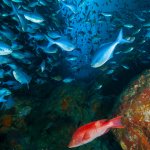Bay of Islands Marine Mammal Sanctuary
The purpose of the Sanctuary is to reduce known pressure from vessel and human interactions on marine mammals in Te Pēwhairangi / Bay of Islands, and to give them the opportunity to visit these waters safety. The Sanctuary allows users to continue to use and enjoy the waters of Te Pēwhairangi / Bay of Islands, but in a way that is safe for marine mammals. Research shows behavioural changes and a dramatic drop in the number of bottlenose dolphins visiting the Bay – a taonga species for local kaitiaki, and an iconic species for the community. Bottlenose dolphins are an indicator species for other marine mammals.
Effects from vessel and human interactions impact all marine mammals.
The Bay of Islands Bottlenose dolphins were heading forwards being locally extinct within a few years. There were 278 Bay of Islands Bottlenose dolphins in 1999 down to 26 in 2020
The warm and sheltered waters of Te Pēwhairangi / Bay of Islands mean we have a high number of
people in the water. This is a particularly important issue to address in Te Pēwhairangi / Bay of Islands. When marine mammals come over to look at you or interact with you when you are swimming or doing another activity in the water, it might seem like they are enjoying the interaction. However, it is important to remember that when they do this, it is stopping their natural survival behaviours, such as resting and feeding. In Te Pēwhairangi / Bay of Islands this is particularly problematic because bottlenose dolphins spend 86% of daylight hours surrounded by vessels or humans. Biologically, interacting with a marine mammal in their environment (by being in the water) causes one of the highest levels of disturbance, particularly for mothers and calves, who are especially vulnerable. Mothers stop feeding their babies and are distracted from their care when interacting with people in the water.
Every person must: maintains a minimum 300m distance from any marine mammal in the marine mammal sanctuary and marine mammal safe zones; or
– stops their vessel if the person in charge becomes aware of any marine mammal less than 300m distance in the marine mammal sanctuary and marine mammal safe zones; or
– remains stopped until any marine mammal is more than 300m away in the marine mammal
sanctuary and marine mammal safe zone
How do I comply with this restriction if I am diving?
Safety always comes first.
If you encounter a marine mammal once you have commenced your dive:
– Stay together as a group.
– Don’t deviate from your dive plan.
– You don’t need to exit the water (remember safety is first).
– Maintain your depth and enjoy watching the marine mammal respectfully.
– Don’t pursue interactions with the marine mammal.
– When you surface from your safety stop, move swiftly to the vessel (or shore) and exit the
water if it is safe to do so.
– Don’t re-enter the water until the marine mammal is more than 300m away.
With diving preparation is key. Prior to entering the water for a dive plan for the above actions:
– include actions that will be taken if you encounter a marine mammal in your pre-dive safety
briefing.
– ensure that these actions are captured in your dive plan.- ensure that your surface safety person, and/or skipper, does a thorough scan for marine mammals before anybody enters the water (from either shore or a vessel). If there are marine mammals present within 300m of your entry point, do not enter the water until they are more than 300m away.
How do I comply with this restriction if I am swimming or snorkelling?
Safety is also first while snorkelling or swimming, but unlike diving, it is generally safe to exit the waterupon becoming aware of marine mammals.
Prior to entering the water for a swim or snorkel:
– Do a scan of the water.
– If you see any marine mammals, delay your swim or snorkel until they are 300m away.
If you encounter a marine mammal once you have commenced your swim or snorkel:
– Exit the water at your closest safe exit point and remain out of the water until the marine
mammals are 300m away (and heading away from you).
– The closest exit point may not be the point you entered from.
– Once marine mammals are more than 300m away, you can continue your swim or snorkel.
What about activities on the shore edge (e.g. wading, walking in the intertidal zone)?
Activities on the shore edge includes things like gathering seafood whilst wading, cooling off in the
shallows, surf cast fishing, getting on and off water toys (such as wake boarding, jet skis, kitesurfing, tubing from the shore), and getting in and out of watercraft (kayaks, paddleboards).
Safety comes first, however when doing activities on the shore edge, it is generally safe to exit the
water upon becoming aware of marine mammals.
Prior to entering the water for activities:
– Do a scan of the water.
– If you see any marine mammals, delay entering the water until they are 300m away.
If you encounter a marine mammal once you have started your activity on the shore edge:
– Exit the water at your closest safe exit point and remain out of the water until the marine
mammals are 300m away (and heading away from where you are).
– The closest exit point may not be the point you entered from.
– Once marine mammals are more than 300m away, you can continue your activity.




